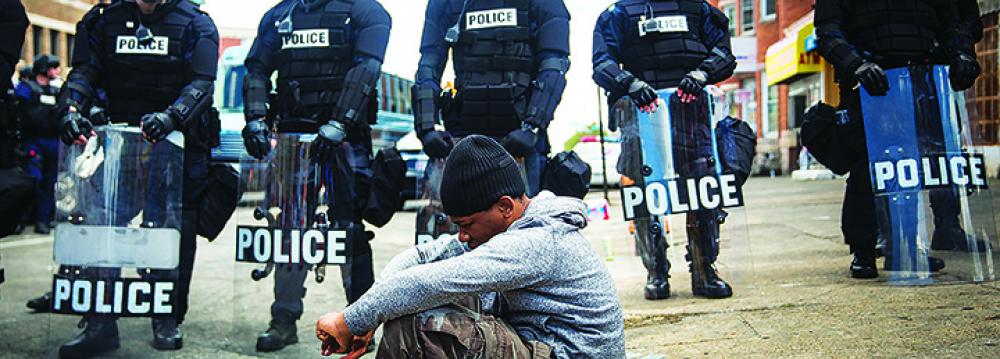The unrest in Baltimore after the death of 25-year-old Freddie Gray after he was critically injured in police custody has reopened longstanding debates over public-order policing. Where does protest end and rioting begin? What counts as violence? Is property damage ever legitimate? Listening to Fox News analyze the meaning of the word “thugs,” it feels as if we are doomed to repeat Martin Luther King Jr.’s quote “Riots are the language of the unheard” until we are blue in the face, Anna Feigenbaum wrote for Al-Jazeera.
Baltimore, like Ferguson, Missouri, has seen the deployment of a hyper-technologized warrior-cop style of policing that has become unnervingly familiar, with recent revelations of focusing further on the militarization of law enforcement. But these practices of so-called riot control are far from new.
Riot control is — and always has been — about criminalizing acts of disobedience by controlling people, public space and even the air we breathe. The disturbing forms of policing we see in Baltimore provide a small window into a sprawling, transnational business with roots in colonialist violence.
Industry of Repression
Riot control largely arose out of the repression of rebellious peasants and slaves. Early forms of policing in the US included slave patrols that searched residences, broke up gatherings and monitored roads. These modernized police officers enforced public order, intervening in the daily lives and leisure activities of working-class and minority neighborhoods. This nascent form of broken-windows policing created tensions between officers and community members. Early police forces were also used to protect economic interests, breaking up labor organizing and strike activity among the working classes.
Early riot control tactics included various police formations — the interlocked arm formation that uses officers’ batons to cordon off areas, the show of force demonstration that works psychologically and physically by making a surprise advance on a crowd, and the boxing in of public areas by occupying and sealing off intersections.
We saw such space-based control practices play out in Baltimore on April 27. With public transportation cut off and streets blocked by heavily armored, shield-barrier police lines, people were trapped — forced to fight or attempt to flee, risking arrest and further brutality.
Such acts of entrapment and suffocation are most visible when tear gas is also deployed, as police did in Modawmin, along with pepper balls. While pepper balls (PDF) and spray tanks filled with tear gas are modern inventions, the practice of poisoning the air to control populations has been used by US law enforcement for nearly a century.
In Baltimore, tear gas pollutes an already toxic urban atmosphere. The city’s youth population under 18 has an asthma rate of more than 20 percent — twice the national average — vastly increasing the medical dangers of policing with chemical weaponry. Reports of skin burns, concussions and wounds from people on the streets suggest that riot control agents were fired at close range, in closed-off locations and in dangerously high doses.
Transnational Trade
These bodily and spatial policing practices reflect Israeli military and police training for controlling the occupied territories. Baltimore Police Department representatives have received training overseas from Israeli experts. Training happens at home as well, from former Israel Defense Forces soldiers such as B.K. Blankchtein, who educated officers at the Maryland Police and Correctional Training Commission from 2008 to 2011.
Private companies specializing in Israeli enforcement also train Baltimore officers in control techniques. The Israeli Tactical School operates a number of programs in Maryland, including the Warrior Weekend, fashioned after training at the Israeli Counter Terror School. For $1,500, participants receive tactical education in, as the company’s website puts it, “the Israeli Individual Warrior doctrine designed to win the fight against all odds.”
The riot control market is driven by the increase in the demand for these systems amongst law enforcement agencies due to the economic crisis and political unrest prevailing in the nations, which results into riots or protests by the public against any authority. When that authority is the police, there are sales opportunities on all sides.
Today the companies arming Baltimore’s law enforcement officers are profitable corporations with global product reach. Combined Systems Inc. — which also arms Israeli forces — equips police with weapons such as the Triple Phaser smoke grenade.
As unrest in Ferguson and Baltimore continues (and riot control business opportunities boom), it is time to do away with the false dichotomy of the protest-versus-riot debate. Though the weapons are more military grade — and the tactics more revenue-driven — the motivations remain the same.
The theatrics of riot control were designed to distract attention from the causes of injustice while destroying the dignity of those who contest them. As a doctrine based on colonial power, riot control erodes any real meaning in the right to free speech or public assembly. It denies the basic freedom to breathe together.


